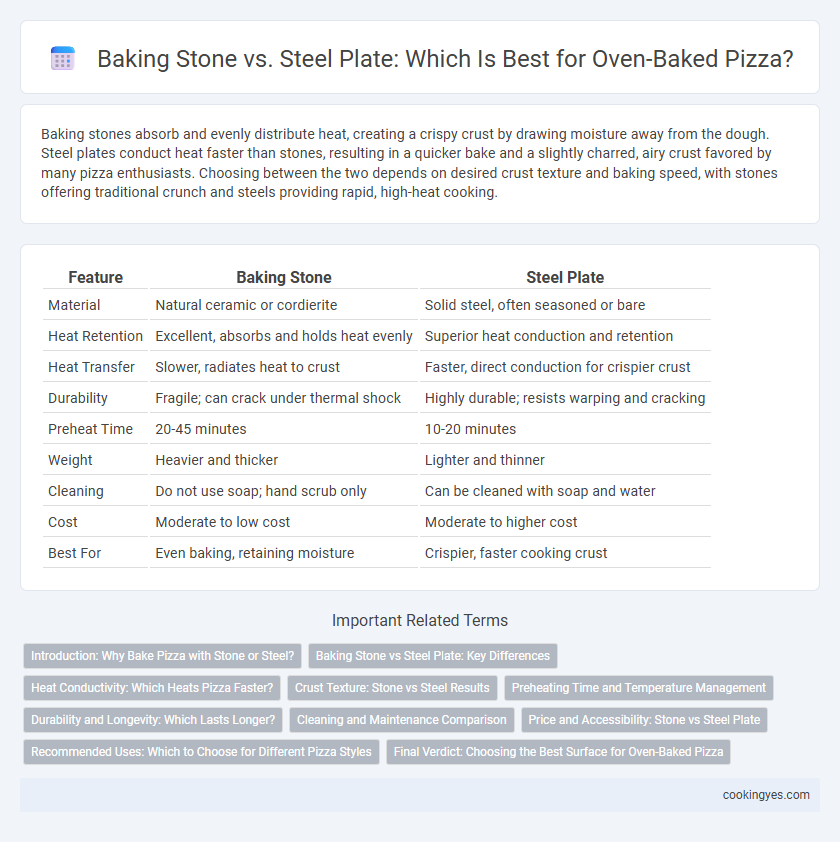Baking stones absorb and evenly distribute heat, creating a crispy crust by drawing moisture away from the dough. Steel plates conduct heat faster than stones, resulting in a quicker bake and a slightly charred, airy crust favored by many pizza enthusiasts. Choosing between the two depends on desired crust texture and baking speed, with stones offering traditional crunch and steels providing rapid, high-heat cooking.
Table of Comparison
| Feature | Baking Stone | Steel Plate |
|---|---|---|
| Material | Natural ceramic or cordierite | Solid steel, often seasoned or bare |
| Heat Retention | Excellent, absorbs and holds heat evenly | Superior heat conduction and retention |
| Heat Transfer | Slower, radiates heat to crust | Faster, direct conduction for crispier crust |
| Durability | Fragile; can crack under thermal shock | Highly durable; resists warping and cracking |
| Preheat Time | 20-45 minutes | 10-20 minutes |
| Weight | Heavier and thicker | Lighter and thinner |
| Cleaning | Do not use soap; hand scrub only | Can be cleaned with soap and water |
| Cost | Moderate to low cost | Moderate to higher cost |
| Best For | Even baking, retaining moisture | Crispier, faster cooking crust |
Introduction: Why Bake Pizza with Stone or Steel?
Baking pizza with a stone or steel plate enhances crust texture by providing high, even heat that mimics traditional brick ovens. Stone absorbs moisture, creating a crispy, chewy base, while steel offers superior heat conduction for faster cooking and a perfectly blistered crust. Choosing between stone and steel depends on desired crust characteristics and oven performance efficiency.
Baking Stone vs Steel Plate: Key Differences
Baking stones are porous ceramic materials that absorb moisture from pizza dough, resulting in a crispier crust, while steel plates conduct heat more efficiently, providing faster and more even cooking. Steel plates typically reach higher temperatures quickly, supporting better oven spring and browning compared to baking stones, which can take longer to preheat. The choice between baking stone and steel plate depends on desired crust texture and baking speed, with steel offering durability and versatility for various oven types.
Heat Conductivity: Which Heats Pizza Faster?
Steel plates offer superior heat conductivity compared to baking stones, allowing pizzas to heat faster and achieve a crispier crust in less time. Baking stones retain heat well but warm up more slowly, which can result in longer cooking times and more even heat distribution. For rapid oven heating and quicker pizza baking, steel plates are typically the preferred choice among professional chefs.
Crust Texture: Stone vs Steel Results
Baking stones provide even heat distribution that absorbs moisture, resulting in a crisp and slightly chewy crust often favored for traditional Neapolitan-style pizzas. Steel plates conduct heat more efficiently, producing a faster bake and a crust with a distinctively blistered, airy texture due to the intense heat transfer. When comparing crust texture, stones yield a Crunchier bottom while steels offer a lighter, more oven spring-driven lift and blistering.
Preheating Time and Temperature Management
Baking stones require longer preheating times, often up to an hour at 500degF, to evenly retain heat, while steel plates reach optimal baking temperature faster, usually within 30 minutes. Steel's superior thermal conductivity allows for more precise temperature management and quicker heat recovery after opening the oven door. This results in a crispier crust and consistent baking performance, making steel plates ideal for high-temperature pizza ovens.
Durability and Longevity: Which Lasts Longer?
Baking stones, typically made from ceramic or cordierite, offer good heat retention but are prone to cracking under thermal shock, reducing their durability over time. Steel plates, constructed from thick, food-grade stainless steel, provide superior durability and resistance to warping or cracking, resulting in a longer lifespan for frequent oven baking. Steel's robustness and minimal maintenance make it a preferred choice for longevity in pizza baking tools.
Cleaning and Maintenance Comparison
Baking stones require thorough drying after cleaning to prevent cracks and maintain their porous surface, which absorbs moisture and avoids sogginess in pizza crusts. Steel plates, being non-porous, are easier to clean with just mild soap and water, and they resist rusting when dried properly. Maintenance for baking stones involves occasional seasoning to preserve their heat retention, whereas steel plates benefit from regular wiping to prevent food buildup and corrosion.
Price and Accessibility: Stone vs Steel Plate
Baking stones are generally more affordable and widely accessible in kitchen stores and online retailers, making them a popular choice for beginner and budget-conscious pizza enthusiasts. Steel plates, while pricier due to their durability and superior heat conduction, may have limited availability and higher shipping costs because of their weight. Choosing between stone and steel often depends on balancing initial investment with desired cooking performance and durability.
Recommended Uses: Which to Choose for Different Pizza Styles
Baking stones excel in retaining even heat and are ideal for Neapolitan-style pizzas that require a crispy crust and quick bake at high temperatures. Steel plates offer superior thermal conductivity, making them perfect for New York-style or thicker pizzas that benefit from rapid heat transfer and a crunchy bottom. Choosing between stone and steel depends on the pizza style, with stones favored for traditional, thin-crust pizzas and steels preferred for thicker, cheesier varieties.
Final Verdict: Choosing the Best Surface for Oven-Baked Pizza
Baking steel outperforms baking stone by offering superior heat conductivity, resulting in a crispier crust and faster cooking times for oven-baked pizza. While baking stones retain heat well and provide even cooking, baking steels deliver more consistent high temperatures essential for optimal pizza texture. For home pizza enthusiasts seeking restaurant-quality results, a baking steel is generally the best surface choice for oven baking.
Baking stone vs Steel plate for oven baking Infographic

 cookingyes.com
cookingyes.com